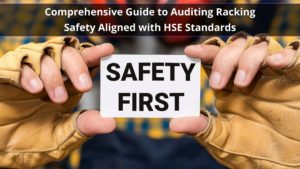
Businesses who ignore the SEMA Code of Practice’s advice on load notices run the risk of more than fines.
The SEMA Code of Practice states that load notices are safety notices for racking systems which are included on all racking systems provided by SEMA approved distributor companies. Load notices explain to the end users of a racking system how the system should be used and what the system’s limitations are.
The advice is approved by HSE, but it is not the only advice that end users need to follow when using racking. Rather, load notices are intended as summaries or quick reminders of HSE approved advice for the safe use of racking.
Load notices do not replace the need for employers to train their staff on the safe use of racking systems, for example.
All SEMA approved racking systems have had SEMA load notices on them since the 1980s. These notices have since been updated with input from the SEMA Code of Practice, HSE, and the EU.
According to HSE, not every racking system provider needs to be a SEMA distributor company. However, HSE’s HSG76 states that all racking systems need some kind of load notice and refers to SEMA’s advice on load notices as an example how load notices should be. To understand SEMA load notices a bit better, it’s good to understand their history.
Brief History: SEMA Code of Practice Creates SEMA Load Notices; EU & HSE Improve Them
The earliest SEMA load notices were mentioned in the original SEMA Code of Practice for Use of Static Pallet Racking in the ‘80s. Some SEMA approved racking systems still have these load notices. However, SEMA load notices have since evolved because of input from the EU, HSE, and updates to the SEMA Code of Practice itself.
EC Directive 92/58/EEC was announced by the EU in June 1992. This EU directive outlined the ways health and safety signs at work should look. EU directives are not the same as EU regulations. An EU directive sets out an objective to be achieved and it is then up to each individual member state to achieve this objective in its own way.
As a result, it wasn’t until four years later that the UK turned this EU directive into British law, with the implementation of the Health and Safety (Safety Signs and Signals) Regulations 1996. SEMA load notices were modified to adhere to these regulations.
The main changes were to the colours and the designs of the different kinds of notices on the racking equipment. The original SEMA load notices used their own design as outlined in the original SEMA Code of Practice. These new ones now adhere to the national standard for safety signs and subsequent SEMA Codes of Practice have been updated accordingly.
Red circular signs with white backgrounds and black pictograms are used for prohibition. Yellow triangular signs with yellow backgrounds and black pictograms or text are used for warning. Green rectangular signs with white pictograms or text are used for instruction. Blue rectangular signs with white pictograms or text are used for mandatory actions.
You may notice how all safety signs in workplaces across the UK follow these regulations. “No smoking” signs are red. Caution of fire signs are yellow. “Fire exit” signs are green. “Hardhats must be worn in this area” signs are blue. SEMA load notices now adhere to these same regulations as well.
What Do SEMA Load Notices Say?
Different racking systems have different load notices, but most follow a similar structure. A typical SEMA load notice outlines the need for regular racking inspection from a SEMA approved inspector, the need to adhere to the SEMA Code of Practice, and the need to contact the supplier of the system if you unsure about anything as yellow warning signs. A mandatory action is given in blue that all damage should be reported to the racking safety officer. Finally, a red sign prohibits climbing on a racking system or altering the racking system. All of this information is listed on the left of the load notice.
On the right of the load notice are the maximum load recommendations for each shelf, as well as the maximum bay load. Bear in mind that the maximum bay load is often less than the sum total of all the shelf loads.
For example, if you have a system with four shelves and each shelf can handle two loads of 1,000kg, but the bay load is 5,000kg, you must make sure that your total bay load is below 5,000kg. Each individual shelf combined might be able to handle 8,000kg, but the bay load is there to tell you how much your whole racking system can handle at one time.
If you have any questions about SEMA load notices, don’t hesitate to contact Storage Equipment Experts. Remember that following the advice given on a SEMA load notice is not a replacement for racking inspection training or expert racking inspections from a SEMA approved racking inspector.
For professional racking inspection services from a SEMA approved racking inspector with acute knowledge of the SEMA Code of Practice, contact Storage Equipment Experts today.





